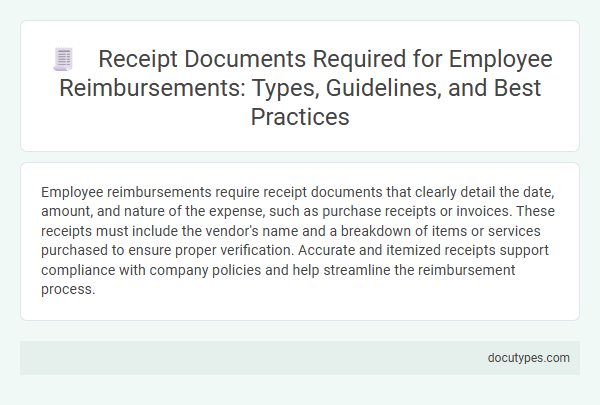Employee reimbursements require receipt documents that clearly detail the date, amount, and nature of the expense, such as purchase receipts or invoices. These receipts must include the vendor's name and a breakdown of items or services purchased to ensure proper verification. Accurate and itemized receipts support compliance with company policies and help streamline the reimbursement process.
Introduction to Receipt Documents for Employee Reimbursements
Receipt documents play a crucial role in the employee reimbursement process. These documents serve as proof of expenses incurred during business activities.
You must submit accurate and detailed receipts to ensure timely reimbursement. Common receipt types include invoices, payment confirmations, and merchant receipts.
Importance of Accurate Receipt Submission
Accurate receipt submission is crucial for processing employee reimbursements efficiently. Proper documentation ensures compliance with company policies and tax regulations.
- Itemized Receipts - Provide a detailed breakdown of expenses to verify each charge for reimbursement.
- Official Proof of Purchase - Serve as legal evidence required for accounting and auditing purposes.
- Timely Submission - Helps avoid delays in reimbursement and maintains transparent financial records.
Your careful attention to submitting correct receipt documents supports smooth reimbursement processing and financial accountability.
Common Types of Receipts Accepted for Reimbursement
Receipts play a crucial role in the employee reimbursement process by serving as proof of expenses. Understanding the common types of receipts accepted for reimbursement can help streamline your claim submissions.
- Original printed receipts - These are official paper receipts provided at the point of sale, detailing the transaction date, items purchased, and total cost.
- Digital receipts - Emailed or app-generated receipts that include all purchase details and are accepted when clearly legible and unaltered.
- Itemized receipts - Receipts listing each product or service separately, often required to verify specific reimbursable expenses.
Essential Information Required on Receipts
Receipts submitted for employee reimbursements must contain essential information to ensure proper validation and compliance. Key details include the date of the transaction, merchant name, and itemized list of purchased goods or services.
Additionally, the receipt should display the total amount paid and the payment method used. Clear and legible receipts help streamline the reimbursement process and prevent delays or disputes.
Company Guidelines for Receipt Documentation
What receipt documents are required for employee reimbursements? Company guidelines for receipt documentation typically mandate original, itemized receipts that clearly show the date, vendor, and amount paid. You must ensure receipts comply with these criteria to guarantee timely and accurate reimbursement processing.
Digital vs. Paper Receipts: Acceptability and Standards
Employee reimbursements require valid receipt documents to verify expenses accurately. Digital receipts are increasingly accepted due to their convenience, legibility, and ease of storage, provided they meet company standards such as clear vendor details, date, and amount. Paper receipts remain acceptable but must be legible and unaltered to comply with auditing requirements and regulatory guidelines.
Handling Missing or Lost Receipts
| Receipt Documents Required for Employee Reimbursements |
|
|---|---|
| Handling Missing or Lost Receipts |
|
Best Practices for Organizing Receipts
Proper management of receipt documents is essential for accurate employee reimbursements and financial transparency. Best practices for organizing receipts ensure compliance and streamline the reimbursement process.
- Collect Detailed Receipts - Receipts must include the date, vendor name, itemized purchases, and total amount to validate expenses accurately.
- Use Digital Storage Solutions - Scanning and storing receipts electronically improves accessibility and reduces the risk of loss or damage.
- Implement a Consistent Filing System - Categorizing receipts by date, project, or expense type simplifies retrieval and audit preparation.
Receipt Verification and Approval Processes
Receipts serve as essential proof for employee reimbursements, confirming that expenses are legitimate and comply with company policies. Proper receipt documents must include details such as the date, vendor name, itemized list, and total amount to ensure accurate verification.
Receipt verification involves cross-checking submitted documents against expense reports and company guidelines. Approvers review receipts to confirm authenticity, completeness, and relevance before authorizing reimbursement. You should ensure all receipts are clear, legible, and aligned with the claimed expenses to facilitate a smooth approval process.
What Receipt Documents Are Required for Employee Reimbursements? Infographic

